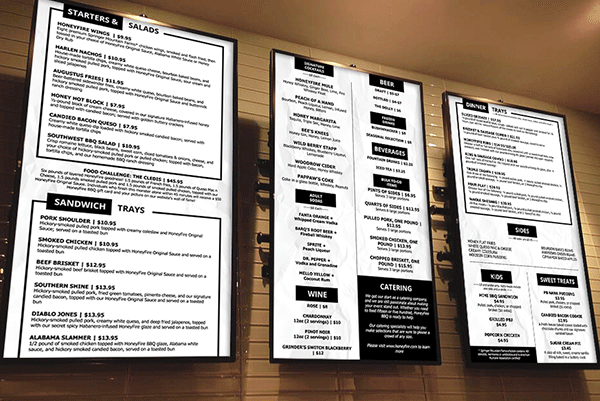In the world of restaurant design, the menu board holds a special place of importance. It serves as the primary point of interaction between a restaurant and its customers, conveying not just the items available for purchase but also the overall brand image and personality. Over the years, menu board design has evolved significantly, from simple chalkboards to sophisticated digital screens. In this article, we will explore the latest trends in menu board design and how restaurants are leveraging technology to create visually appealing and engaging displays that drive sales and enhance the dining experience.
The Rise of Digital Menu Boards
Dynamic Content
- One of the key advantages of digital menu boards is the ability to display dynamic content. Restaurants can easily update their menus in real-time to showcase daily specials, promotions, or seasonal offerings.
- This flexibility allows restaurants to respond to changing customer preferences and market trends quickly, ensuring that the menu remains fresh and relevant.
Interactive Elements
- Some digital menu boards feature interactive elements that allow customers to browse the menu, customize their orders, or even place their orders directly from the screen.
- This level of interactivity can enhance the customer experience and streamline the ordering process, leading to increased efficiency and customer satisfaction.
Design Trends in Menu Boards
Minimalist Design
- Many restaurants are opting for a minimalist design approach for their menu boards, focusing on clean layouts, simple typography, and high-quality images.
- This design trend helps to highlight the food items and prices effectively, making it easier for customers to navigate the menu and make informed decisions.
Use of Digital Signage Software
- Restaurants are increasingly leveraging digital signage software to create visually stunning and dynamic menu board displays.
- These software solutions offer a range of customization options, allowing restaurants to incorporate animations, videos, and eye-catching graphics into their menu boards.
Personalization and Localization
Personalized Recommendations
- Some restaurants are exploring the use of digital menu boards to provide personalized recommendations to customers based on their previous orders or dining preferences.
- This level of personalization can help to enhance the dining experience and foster customer loyalty by offering tailored suggestions that resonate with individual tastes.
Localization of Content
- For chain restaurants with multiple locations, digital menu boards offer the ability to localize content based on regional preferences, dietary restrictions, or cultural nuances.
- By tailoring the menu board content to specific locations, restaurants can better connect with their diverse customer base and drive engagement at the local level.
Conclusion
From chalkboards to digital screens, menu board design has come a long way, evolving to meet the changing needs and preferences of both restaurants and customers. The latest trends in menu board design focus on creating visually appealing displays that are not only informative but also interactive, personalized, and localized. By leveraging technology and innovative design strategies, restaurants can elevate the dining experience, drive sales, and build stronger connections with their patrons. As technology continues to advance, we can expect to see even more exciting developments in menu board design that enhance the overall restaurant experience.
